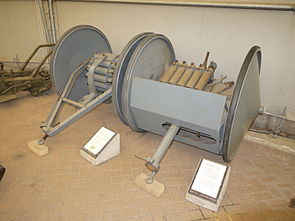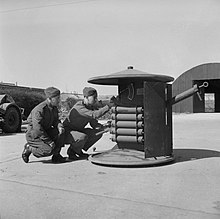Smith Gun
| Smith Gun | |
|---|---|
| General Information | |
| Military designation: | 3 inch OSB |
| Manufacturer country: | United Kingdom |
| Development year: | 1940 |
| Start of production: | 1941 |
| Number of pieces: | 4000 |
| Weapon Category: | Anti-tank gun |
| Team: | three soldiers |
| Technical specifications | |
| Pipe length: | 137 cm |
| Caliber : |
76.2 mm |
| Caliber length : | 17th |
| Elevation range: | up to + 40 degrees |
| Side straightening area: | 360 ° |
The Smith Gun , also called "3 in. OSB" (Ordonance Smoothbore Gun), was an anti-tank weapon that was produced during the Second World War from 1940 as part of an armaments emergency program for the British Home Guard and issued to their units, but never in one Combat was used.
development
The Smith Gun was designed in 1940 by a developer of the same name from Trianco Engineering and was later offered for sale to the state.
Structure and use
The weapon consisted of two oversized steel wheels, between which a protective shield, ammunition holders and a launch tube were mounted. The wheels were designed differently: the outside of one was flat, that of the other was curved.
The Smith Gun and a similarly designed ammunition trailer could be pulled to the scene by a vehicle or by the crew. In the case of motorized towing, the ammunition trailer was attached to the towing vehicle, while the cannon itself was attached to the ammunition trailer via a bracket on the muzzle of the gun barrel. On reaching the scene of action, the team tilted the 273 kg weapon 90 ° so that the flat outside of the wheel became the base plate. The weapon could then be rotated 360 ° along the axis of the wheel without tools.
The 137 cm long gun barrel itself was attached roughly in the middle between the wheels. It was an inexpensive smooth- barreled construction in order to be able to fire standardized 7.62 cm (3 inch) grenades, which were available as high explosive grenades and as shaped charge projectiles . Since the Smith Gun could only absorb a little recoil on its narrow base plate , a weak propellant charge had to be used, and the projectiles flew correspondingly slowly. In order to still be able to achieve an acceptable range, the tube could be pointed up to 40 ° and the grenades could hit targets up to 500 meters away. The maximum range was around 800 meters. However, it was only possible to hit exactly up to a distance of about 100 or 200 meters. The penetration rate with the shaped charge grenade is stated to be up to 80 mm armor steel. However , the weapon was not considered to be very effective against the heavier types of Wehrmacht tanks that appeared later in the war.
About 4,000 pieces of the Smith Gun were built. Because of some accidents with the ammunition, it had a bad reputation with the Royal Air Force , which had received some of the weapons used to secure airfields, but was valued by some units of the Home Guard.
The weapon was never used in combat and was retired in 1945.
Web links
literature
- GHQ HOME FORCES: The 3inch OSB Gun, Smith Gun. 1940.
Individual evidence
- ↑ "Smith Gun" on home-guard.org.uk (English)
- ^ A b c d Jeff Kinard: Artillery: An Illustrated History of Its Impact. ABC Clio, 2007, ISBN 978-1-85109-556-8 , p. 270.
- ↑ a b c Stephen Cullen: In Search of the Real Dad's Army: The Home Guard and the Defense of the United Kingdom 1940-1944. Pen & Sword Military, 2011.
- ^ Bernard Lowry: British Home Defenses 1940-1945. Osprey Publishing, 2004, ISBN 1-84176-767-0 , p. 16.
- ^ Bob Osborne: Smith gun. Private web presence (English)


